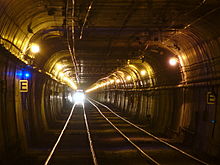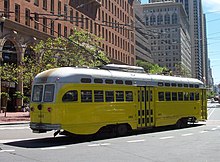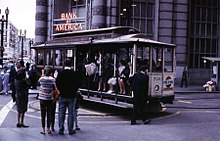San Francisco Municipal Railway
The San Francisco Municipal Railway , or " Muni " for short , is the municipal transport company of the city of San Francisco . It operates the Muni Metro light rail , the San Francisco trolleybus , the San Francisco Cable Cars , the historic F Market & Wharves and E Embarcadero tram lines, as well as numerous diesel bus routes .
history
prehistory
After the earthquake in San Francisco , in which on April 18, 1906 and in the following days, a third of the city of San Francisco and numerous traffic routes in the city was destroyed, the largest transport company in the city, the United Railroads of San Francisco (URR) built one Most of the cable car routes were converted to electric trams. As a result of the enormous costs of this conversion, wages could not be increased and the working conditions of the driving staff deteriorated drastically, as overcrowded cars were the order of the day. This led to strikes in 1907, some of which resulted in violence after armed strikers were taken from other cities by the railway company. The popularity of the railway company declined due to these events and after some tram routes could not be expanded as required, the city decided to set up a municipal operation. A referendum was held on December 30, 1909, and 31,185 voters supported the company, while 11,694 voted against.
Lanes along Geary Street
The concession of the formerly independent Geary Street, Park and Ocean Railway , operated by the URR , expired in 1912 and the city did not renew it, as it did not want to continue to carry the cable cars of this line, but rather its own electric tram along Geary Street wanted to build. On May 5, 1912, the cable car route was shut down after the overhead line had already been built. After renovations, the city's first municipal tram went into operation on December 28, 1912. Line A now ran from Geary St / Market St junction through Geary Street and 10th Avenue to Golden Gate Park (10th Avenue and Fulton Street junction). A shuttle line B ran from Geary Street / 10th Avenue to Geary Street / 33rd Avenue.
After the concession of the Sutter Street Railway , at that time a subsidiary of the URR, had expired, the Muni took over their tracks on Market Street . The four-track system between Sutter Street and Ferry Building consisted of two inner tracks belonging to the URR subsidiary Market Street Railway and the two outer tracks of the Sutter Street Railway. On June 25, 1913, she extended her tram over these tracks to the Ferry Building at the end of Market Street, where she drove a turning loop that was also formerly part of the Sutter Street Railway. The Sutter Street Railway's URR lines now ran the inner tracks on Market Street. In order to connect the route from Geary Street to the outer tracks in Market Street, the four-track system was extended from Sutter to Geary Street. On the same day the extension from 33rd Avenue through this, Balboa Street, 45th Avenue, Cabrillo Street to 49th Avenue (today La Playa Street) went into operation. Line B now also drove from there to the city center to the Ferry Plaza.
Expansion of the network
In 1913 the Muni took over the only line of the Presidio and Ferries Railroad whose concession had expired and referred to it as Line E. It ran from the Presidio to Ferry Plaza, through Baker Street, Union Street, Van Ness Avenue, Vallejo Street, Larkin Street, Union Street, Columbus Avenue, Jackson Street (downtown) or Washington Street (country), and the Embarcadero.
In 1914, the Muni opened an infrequent branch line from Geary Street through Masonic Avenue to the corner of Turk Street to connect Masonic Cemetery and Ball Park, where sporting events were held. Additional trains on Line A went there at events and on Sundays. From August 15, 1914, the new H line ran from Fort Mason (loop on Laguna Street) via Van Ness Avenue, 11th Street, 14th Street, Potrero Avenue to the corner of Army Street (now Cesar Chavez Street). The new Line D ran from Chestnut Street / Laguna Street via Chestnut Street, Van Ness Avenue, Geary Street and Market Street to Ferry Plaza. Another route was taken over after the license of a URR subsidiary expired. Line C now ran from Ferry Plaza via Market Street, Geary Street, 2nd Avenue, Cornwall Street, California Street to Lincoln Park.
Also in 1914, on December 29th, the Stockton Street Tunnel was opened. Not only cars passed through it, but also the new tram line F, which ran from Market St / Stockton St through Stockton Street (including the tunnel), Columbus Avenue, North Point Street, Van Ness Avenue and Chestnut Street to the corner of Laguna Street wrong. A Line J ran from the Ferry Building on Line E to Columbus Avenue and then on to North Point Street on the new Line F.
With the opening of the 1915 World's Fair on February 20, 1915, lines G and I went into operation, which were discontinued at the end of the exhibition. Line G ran from the Presidio on Line E to Columbus Avenue, then through the Stockton Street Tunnel to Stockton Street / Market Street. Line I ran on existing tracks from the Presidio via Van Ness Avenue and Geary Street to 33rd Avenue. The J line ran from the start of the exhibition to the end of the F on Chestnut Street. It was also discontinued after the exhibition ended. In 1916, lines D and F were also extended through Chestnut Street to Scott Street. Line D ran from 1918 on Union Street, Steiner Street and Greenwich Street to the Presidio.
Another new line went into operation in 1917. The new J line ran from Market Street through Church Street to the corner of 30th Street. To avoid a route that was too steep, a swivel was built on a separate track between 18th and 22nd Street. Line J is the oldest Muni line that is still used today.
Tunneling
After the success of the Stockton Street Tunnel, Muni planned another tunnel. It should lead under the Twin Peaks and connect the southwestern parts of the city to the tram network. On February 3, 1918 he went into operation with the K line. She drove from Van Ness Avenue / Bush Street through Van Ness Avenue, Market Street, Twin Peaks Tunnel, West Portal Avenue to St. Francis Circle. There were two stations in the tunnel, Eureka Valley (now unused, south of Castro Station) and Laguna Honda (now Forest Hills). Unlike the Stockton Street Tunnel, it was reserved exclusively for tram traffic. Forerunner bus routes ran from Ingleside (Ocean Avenue) and Taraval Street to the tram terminus. Tram tracks should soon be laid on both routes. Line K was extended in 1918 over Ocean Avenue to Brighton Avenue / Grafton Avenue and now, like Line J, went to Ferry Plaza. A new L line ran in 1919 from the west portal of the tunnel through Ulloa Street, 15th Street, Taraval Street to 33rd Avenue.
Two other bus routes started running around this time. Line 1 ran from the terminus of Line A through Golden Gate Park, 9th Avenue, Judah Street, 15th Avenue, Irving Street to 25th Avenue from around 1917. Line 2 ran from January 15, 1918 from the terminus of Line B along the boardwalk, Lincoln Way, 48th Avenue, Kirkham Street, Great Highway Boulevard to the terminus of Line 12 of the Market Street Railway on Sloat Boulevard. In 1923 the L line was extended over Taraval Street to 48th Avenue and on September 15, 1937 over 46th Avenue to the terminus at the zoo. In 1925, another new line went into operation, the M, which ran from St. Francis Circle to Ocean View to Broad Street / Plymouth Avenue. As early as 1939, the M line was replaced by a bus line, but from 1944 it was again operated as a tram.
Another tunnel was built in the 1920s. The Sunset Tunnel opened on October 21, 1928 and connected Duboce Avenue with Carl Street under Buena Vista. The new N Line ran from Market Street via Duboce Avenue, the new tunnel, Carl Street, Arguello Boulevard, Irving Street, 9th Avenue, Judah Street to 48th Avenue. It partially replaced bus line 1, which had been extended on December 15, 1926 via Forest Hills to Gennessee Street.
From June 1, 1932, Line E drove over Van Ness Avenue to Market Street. A new line O ran from Van Ness Avenue over the former route of line E to the Ferry Building. The change was reversed on July 15, 1932. The first line shutdown was on December 5, 1932 on 10th Avenue, when Line A last operated. Bus route 1 was instead extended to Geary Street.
Takeover of the private tram company
Muni took over the streetcar line on Howard Street (line 35) of the Market Street Railway after the concession expired and converted it into a trolleybus line. From September 7, 1941, trolleybuses drove on the route from Howard Street / Army Street (now South Van Ness Avenue / Cesar Chavez Street) via Howard Street to the Ferry Building. Today this route is no longer used as a line, but still serves as a single-lane operating route. The new line received the letter R.
Due to financial problems and outdated equipment and vehicles, the competing Market Street Railway (MSR) was forced to sell its operations to the city during World War II. From September 29, 1944, the trams, trolleybuses and omnibuses of the Market Street Railway drove under the management of the Muni. It took over a network of a total of 41 lines, including some cable car lines. It switched all electric tram lines of the former MSR to bus or trolleybus operation by July 1949. In the meantime, on December 5, 1946, it extended Line H over former MSR tracks through San Bruno Avenue to Arleta Avenue. On September 8, 1947, Line F was extended over 4th Street to the station of the Southern Pacific Railroad and on January 16, 1949 over a loop through 2nd Street back to Market Street. Line K was briefly extended on November 1, 1948 via Ocean Avenue and Onondaga Avenue to Mission Street, but was withdrawn in the 1950s to the depot at Balboa Park, where it still ends today. Line E had already been switched to trolleybus operation (line 41) on April 21, 1947. On March 19, 1950, Muni stopped traffic on lines D and H and instead opened bus route 47. As early as October 20, 1951, route F was also switched to trolleybus operations (route 30).
Another tram company was now in San Francisco. The California Street Cable Railroad owned three cable car lines north of Market Street. It ceased operations on July 31, 1951 for financial reasons. Muni took over the routes and reopened them on January 13, 1952. On May 15, 1954, however, it closed the western section of the line on California Street between Van Ness Avenue and Presidio Avenue, as well as the line on Jones Street and Hyde Street and the short shuttle line on lower Jones Street. On December 29, 1956, operations on the California Street Line were discontinued and the cable was relocated to the depot of the former MSR Cable Cars. On the same day, tram traffic on the Muni trunk line on Geary Street also ended. Lines B and C have been replaced by bus route 38. Line C was shortened to California Street / 2nd Avenue in 1950.
On April 7, 1957, the new Powell & Hyde cable car line opened, running from Powell Street to Washington and Jackson Street on former MSR tracks and then through Hyde Street on former California tracks. The cable car line on California Street reopened on December 27, 1957. The three cable car lines still in operation today, which were already a tourist attraction at the time, as well as the tram lines J (Church Street), K (Ingleside – Balboa Park), L (Taraval Street – Zoo), M ( Ocean View) and N (Judah Street).
From the tram to the light rail
Planning for a rapid transit network began as early as the 1950s. In 1957, the San Francisco Bay Area Rapid Transit District was established, which consisted of the counties of the Bay Area. In November 1962, it was decided to build the BART lines and in 1964 construction work began. The construction comprised a tunnel under downtown San Francisco, which should consist of two floors, the Market Street Subway . The lower floor should be used by the BART rapid transit trains, the upper floor by the Muni trams. The Muni Tunnel was to be connected to the Twin Peaks Tunnel, which opened in 1918, creating a continuous tunnel from the Embarcadero Station near the Ferry Building to the West Portal. The BART route under Market Street opened in 1973, but it was not until February 1980 before the first trams went underground to the city center. The last lines were laid in the tunnel in November 1982. With the opening of the tunnel, the Municipal Railway put new light rail trains into operation, replacing the old trams. In 1980, line M was also extended beyond its previous terminal to the depot at Balboa Park.
However, the tram route on Market Street was preserved and was used by the Market Street Railway Association, founded in 1976, to operate historic trams. From 1995 the new line F operated here, initially from the Transbay Terminal to Castro, and since 2000 on a new line along the Embarcadero from Fisherman's Wharf. Line J was extended in 1992 on a new line along San Jose Avenue to Balboa Park. The line was completed in 1991, but initially only served as an operating line.
In 1998 Muni opened a tunnel ramp on the Embarcadero and a new route to the Caltrain station on 4th Street / King Street. Initially, however, only a shuttle line E operated from the Embarcadero station to the Caltrain station. A few months later, line N was extended to the Caltrain station and the E was discontinued. On April 7, 2007, the new line went into operation from Third Street to Sunnydale Avenue. Since then, line T has been running from there to Embarcadero and the railways there change to line K. In the opposite direction, the line change takes place at the West Portal station. From 2018, Line T will run through the new Central Subway under 4th Street and Stockton Street to Chinatown. The tunnel has been under construction since 2010. The trolleybus overhead line on this route had to be partially dismantled for the tunneling, whereby the lines 30 and 45 in the direction of the Caltrain station through the Mason Street and 5th Street, where new overhead lines were built.
Line network
The Muni light rail and tram lines have been designated with letters since the opening of the company, the bus lines with numbers, sometimes supplemented by letters. Many of the bus route numbers go back to former Market Street Railway tram lines . The cable car lines have internal line numbers 59 to 61, but the letters C, PH and PM are often used on network maps. In addition to the line number, all lines also have a name, which appears both in the timetables and on the vehicles. The destination display for bus lines contains the line number, the line name in capital letters and the actual destination in lower case letters under the line name.
- For lines of rail and trolleybus traffic, see respective main articles: Muni Metro , F Market & Wharves , E Embarcadero , San Francisco Cable Cars , Trolleybus San Francisco
literature
- Grant Ute, Philip Hoffman, Cameron Beach, Robert Townley, Walter Vielbaum: Muni. San Francisco's Municipal Railway. Charleston SC: Arcadia Publishing, 2011. ISBN 978-0-7385-7580-3








